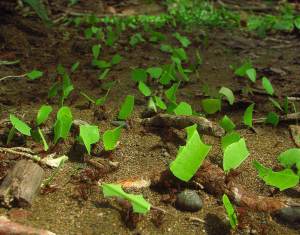
The Smithsonian has a tropical research institute in Panama (STRI), the main laboratory being situated in the middle of the Panama Canal, and as the flood waters rose with the damming of the canal in the early 1900s, they left the site, Barro Colorado, a former hilltop, as a new “island”. With limited human actions since this time, it’s been a great place to study forest ecology and processes.
On my first visit to the island, we learned of researchers who spent their time studying leaf cutter ants, hours of field work and lab time studying communication and social hierarchy within these ant communities. You learned that these little guys don’t actually eat the leaves that they harvest, but have a mutualistic relationship with a type of fungus that lives in their colony, they feed it the leaves and the byproduct is used to feed their young. You hear about how hardworking they are, and how they are exceedingly good at harvesting vegetative material in such as short amount of time – a tree in a day!
So, you’re excited when you hear this. The world is big, we are small, life is complex, this is pretty neat!
Until they’re in your yard.
And they’ve eaten your jobo .
And the nance.
And one of the cacao (chocolate).
And some of the coffee plants.
And you realize that you’re the source of the colony’s prosperity, feeding the next generation.
Then, it doesn’t seem quite as neat.
Upside?
Well, any leaf cutter ant biologists out there who need a new research location to err..contrast ant interactions within the forest environment to modified soil environments? I know of a great place you can go, a great inn where you can stay, and the study site is right near by….evidently prospering.
